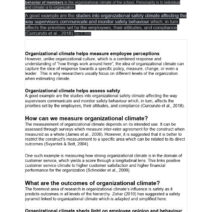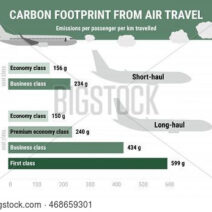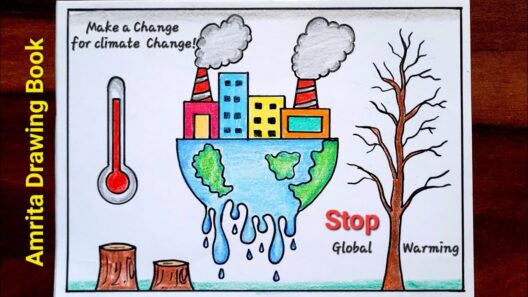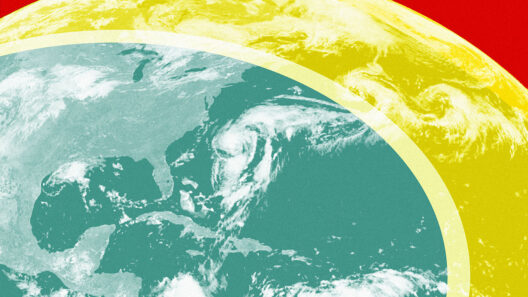As the planet warms, marine ecosystems, which hold an irreplaceable position within the Earth’s biosphere, face unprecedented challenges. The oceans, covering over 70% of the Earth’s surface, are the lungs of our planet—regulating climate, providing food, and supporting a vast array of life. However, the daunting specter of global warming casts a dark shadow over these invaluable resources. The plight of ocean life extends beyond mere temperature fluctuations; it engenders an intricate web of consequences that threaten the very essence of marine biodiversity.
The rise in atmospheric temperatures leads to thermal expansion and the melting of polar ice caps, resulting in rising sea levels. This phenomenon adversely impacts coastal ecosystems, particularly wetlands and mangroves, which serve as critical nurseries for various marine species. These habitats not only support local fisheries but also act as barriers against storm surges and erosion. As sea levels rise, these vital ecosystems diminish, leaving marine life vulnerable to predation and habitat loss. Consequently, the intricacies of the food web are disrupted, impacting both aquatic organisms and the human communities that rely on them for sustenance.
Moreover, warming waters serve as a catalyst for coral bleaching, a process that involves the expulsion of symbiotic algae from coral polyps. These algae, essential for coral health, provide the vibrant colors and nutrients that sustain coral reefs. When temperatures rise, corals become stressed, leading to a phenomenon that leaves gigantic underwater structures ghostly white and devoid of life. Coral reefs are not merely aesthetic wonders; they are among the most biodiverse ecosystems on Earth, hosting approximately 25% of all marine species. The demise of coral reefs would signify an irrevocable loss of biodiversity and a collapse of local fisheries that depend on these habitats.
Alongside the physical changes in ocean temperatures, ocean acidification is a dire offshoot of climate change, driven by the elevated absorption of carbon dioxide (CO2) by seawater. As ocean pH levels decrease, the implications for calcifying organisms, such as mollusks, sea urchins, and corals, are profound. These species struggle to maintain their calcium carbonate structures in more acidic conditions, compromising their survival rates. This, in turn, echoes through the marine food web, affecting predators like fish and larger marine mammals, ultimately challenging the delicate balance of oceanic life.
The plight of marine mammals is also exacerbated by shifting ocean currents, which dislocate prey species and alter migratory patterns. Many of these creatures, which include iconic species such as dolphins and whales, rely on specific feeding grounds that are now increasingly out of reach. This disruption not only affects their feeding success but also has chilling ramifications for their breeding patterns and overall population health. The interconnectedness of species within marine ecosystems means that the decline of one could precipitate the collapse of others, culminating in a cascading effect that is difficult to reverse.
Fish populations are equally impacted by the changing climate. Warm water species are migrating towards cooler waters, often in pursuit of food or suitable breeding grounds. This migration leads to altered fishing patterns that can devastate local economies reliant on traditional fishing zones. Artisanal and commercial fisherfolk face existential threats as fish populations become increasingly erratic. The melancholy reality is that the ocean’s bounty may dwindle, creating food insecurity that spans across continents.
In the face of these challenges, a beacon of hope lies in the potential for restoration and resilience. Marine protected areas (MPAs) have emerged as an essential strategy in combating some of the adverse effects of climate change. By establishing regions where human activity is limited, these sanctuaries allow marine ecosystems to recover and thrive. Evidence suggests that when ecosystems are given the opportunity to rest, they can rebound with remarkable speed, thus emphasizing the importance of prioritizing conservation initiatives.
Technological innovation also plays a pivotal role in addressing these challenges. Utilizing modern tools, scientists are equipping marine biologists with the means to monitor changes in real time through satellite imaging and underwater drones. Such advancements enable researchers to understand the implications of climate change better and formulate effective conservation strategies. The integration of local communities in these efforts fosters a sense of stewardship and responsibility, galvanizing collective action toward the preservation of marine biodiversity.
In addition, enhancing public understanding of the interconnectedness of human actions and marine health is critical. Education serves as a powerful tool—not only to incite awareness about the plight of ocean life but also to inspire individuals to make sustainable choices in their daily lives. Simple acts, such as reducing plastic use, participating in beach cleanups, and advocating for policy changes, contribute to the larger fight against climate change. By nurturing curiosity and fostering a sense of agency, individuals can be mobilized to protect the oceans that sustain us all.
Ultimately, addressing the myriad challenges posed by global warming on marine ecosystems necessitates a multi-faceted approach. This includes international cooperation, grassroots movements, scientific innovation, and community engagement. Ocean life is not merely a resource to be exploited but rather a critical component of the planet’s health. As stewards of the Earth, we must cultivate a deeper respect for the intricacies of marine ecosystems and mobilize collective action to safeguard their future. The promise of regeneration lies not in despair, but in our unwavering commitment to the oceans and the life they harbor.








